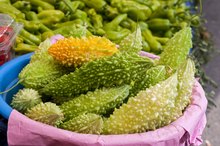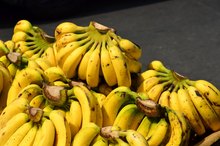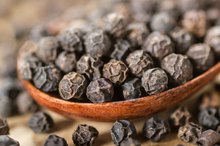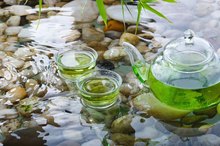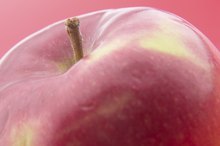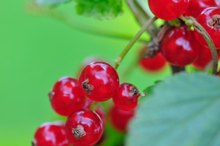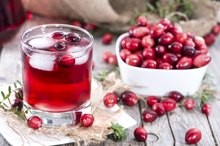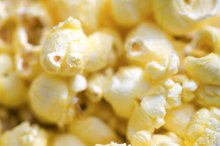Can Eating Too Much Spinach Give You Kidney Stones?
Kidney stones are clusters of crystals that form inside your kidneys. These stones can form when substances normally present in urine -- such as calcium, oxalate or uric acid -- become too concentrated. Your urinary system is usually able to remove small kidney stones without pain, but large kidney stones can be be difficult to pass and can lead to significant pain. Dietary factors such as fluid intake and food choices may play a role in the prevention of most stones. For example, certain people at risk for calcium oxalate kidney stones may get recurrent stones from eating too much dietary oxalate -- including spinach.
Spinach and Kidney Stones
In the body, oxalate naturally binds with minerals such as calcium, magnesium and iron before getting sent into the urine or stool as a waste product. Since oxalate is a component of calcium oxalate kidney stones, restricting dietary oxalate -- including spinach -- has been traditionally recommended as a way to reduce excessive urinary oxalate, and reduce the risk of recurrent kidney stones. However, influences on urine oxalate levels are complex, and excess urinary oxalate is not the primary problem in everyone who suffers from calcium oxalate stones.
Spinach and Urine Oxalate
Bitter Gourd for Kidney Stones
Learn More
While eating a diet high in spinach or other high oxalate foods can cause hyperoxaluria or elevated levels of oxalate in the urine -- and increase the risk of calcium oxalate stones -- a variety of factors can influence the level of this substance in the urine. According to a September 2008 report in “Clinical Journal of the American Society of Nephrology,” increased urine oxalate levels were found in people who were obese and in those with diabetes 15. Younger adults had higher levels compared to older adults. Also, higher calcium in the diet was correlated with lower levels of urine oxalate, and higher vitamin C intake was linked to higher levels. The study authors concluded that the impact of high oxalate foods such as spinach on urine levels of oxalate was small in comparison to some of these other factors.
- While eating a diet high in spinach or other high oxalate foods can cause hyperoxaluria or elevated levels of oxalate in the urine -- and increase the risk of calcium oxalate stones -- a variety of factors can influence the level of this substance in the urine.
- According to a September 2008 report in “Clinical Journal of the American Society of Nephrology,” increased urine oxalate levels were found in people who were obese and in those with diabetes 1.
Effectiveness of Low Oxalate Diets
According to a report in the September 2013 issue of “Expert Opinion on Pharmacotherapy,” whether or not it's necessary to restrict high oxalate foods such as spinach in order to reduce urine oxalate levels depends on the reason for the elevated levels. For example, in people with primary hyperoxaluria, a rare and inherited condition, avoiding spinach or other high oxalate foods may not be of benefit. However, when hyperoxaluria is related to increased gut absorption of oxalate, or if considered idiopathic, which is often milder and not related to a medical condition, dietary oxalate restriction can help. A study published in the December 2013 issue of “Urology” demonstrated that about 50 percent of people with idiopathic hyperoxaluria and a history of kidney stones were able to decrease their urinary oxalate to normal levels by restricting spinach and other high oxalate foods.
- According to a report in the September 2013 issue of “Expert Opinion on Pharmacotherapy,” whether or not it's necessary to restrict high oxalate foods such as spinach in order to reduce urine oxalate levels depends on the reason for the elevated levels.
- For example, in people with primary hyperoxaluria, a rare and inherited condition, avoiding spinach or other high oxalate foods may not be of benefit.
Prevention of Kidney Stones
Bananas to Help Prevent Kidney Stones
Learn More
Drinking plenty of water or other fluids and restricting sodium so that at least 2 liters of urine is produced daily is the most effective dietary strategy to prevent kidney stones. While limiting spinach may help some people at risk for calcium oxalate kidney stones, spinach does not increase the risk of other types of kidney stones. According to the National Institutes of Health, other strategies to reduce kidney stone formation include avoiding excess meat or other animal protein, and in the case of calcium oxalate stones -- eating enough calcium from dietary sources to help bind oxalate in the gut and prevent increased urine levels. In addition, reducing acidity of the urine through medication strategies and by increasing fruit and vegetable intake can help, according to a report in the December 2011 “American Family Physician.”
- Drinking plenty of water or other fluids and restricting sodium so that at least 2 liters of urine is produced daily is the most effective dietary strategy to prevent kidney stones.
- According to the National Institutes of Health, other strategies to reduce kidney stone formation include avoiding excess meat or other animal protein, and in the case of calcium oxalate stones -- eating enough calcium from dietary sources to help bind oxalate in the gut and prevent increased urine levels.
Warnings and Precautions
Kidney stones do not usually produce symptoms until they begin to move down the ureters, or the small tubes that empty urine into the bladder. Symptoms of kidney stones include:
- abdominal
- back or groin pain
- blood in the urine
- fever
- chills
- nausea
- vomiting
If you think you have kidney stones, see your doctor right away. Whether or not you need to restrict spinach or other dietary components depends on the type of stone your have -- so if you pass a stone, try to save it for your doctor to analyze. If your doctor is able to identify the type of stone, treatment and prevention guidelines can be more specific and individualized.
- Kidney stones do not usually produce symptoms until they begin to move down the ureters, or the small tubes that empty urine into the bladder.
- Whether or not you need to restrict spinach or other dietary components depends on the type of stone your have -- so if you pass a stone, try to save it for your doctor to analyze.
Related Articles
References
- Clinical Journal of the American Society of Nephrology: Determinants of 24-hour Urinary Oxalate Excretion
- Expert Opinion on Pharmacotherapy: Kidney Stones: An Update on Current Pharmacological Management and Future Directions
- Urology: Dietary Management of Idiopathic Hyperoxaluria and the Influence of Patient Characteristics and Compliance
- National Institute of Diabetes and Digestive and Kidney Disorders: Kidney Stones in Adults
- Journal of the American Society of Nephrology: Oxalate Intake and the Risk for Nephrolithiasis
- American Family Physician: Treatment and Prevention of Kidney Stones: An Update
- Romero V, Akpinar H, Assimos DG. "Kidney Stones: A Global Picture of Prevalence, Incidence, and Associated Risk Factors." Rev Urol. 2010;12(2-3):e86-96.
Writer Bio
Destiny Simmons has worked as a professional health writer since 2005. She specializes in health and nutrition articles. Her work has appeared in various health Web sites. Destiny holds a Bachelors of Science in nursing from Boston University and a Master of Public Health Nutrition from Tufts University.
